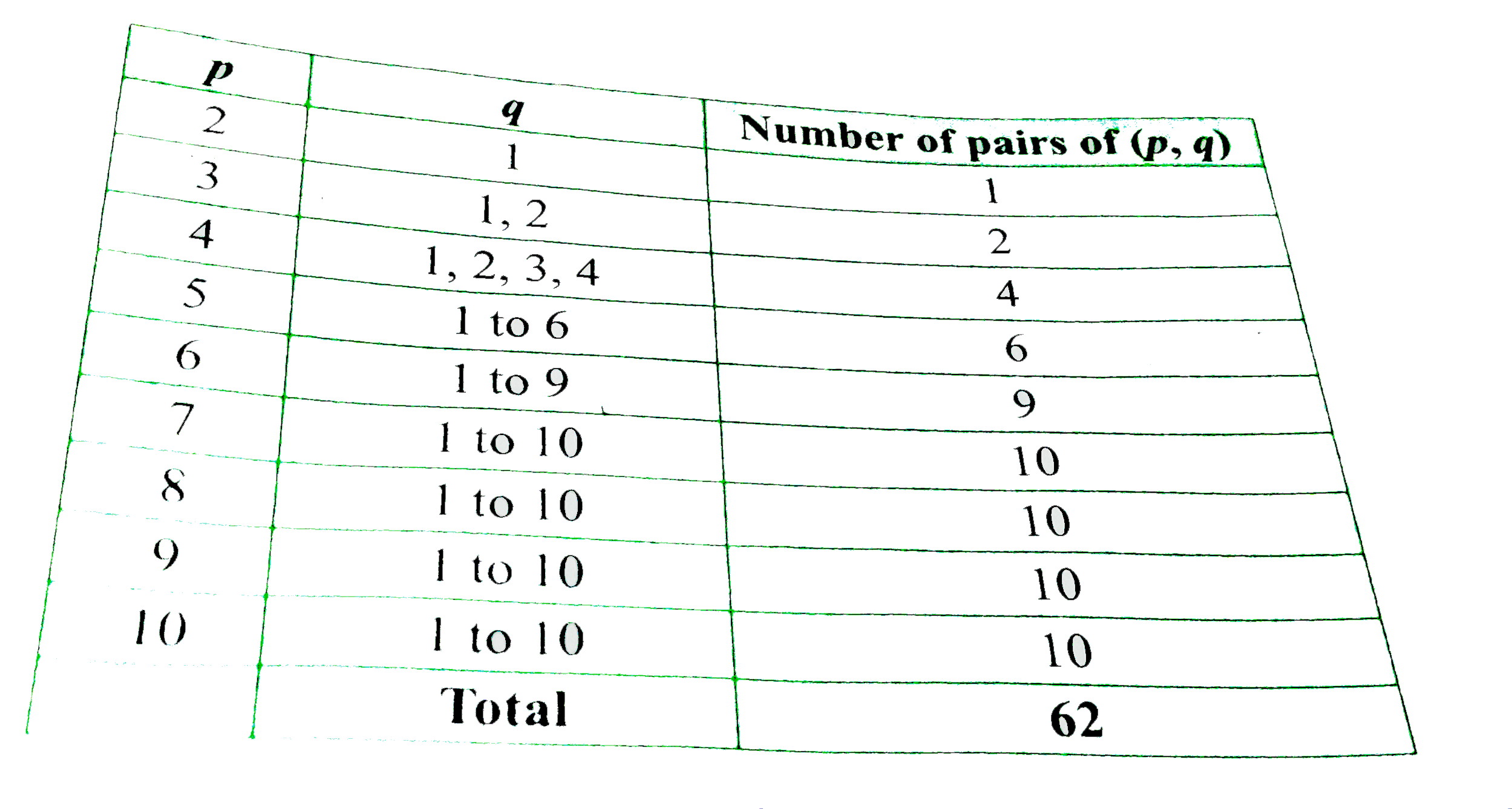If pandq are chosen randomly from the set {1,2,3,4,5,6,7,8,9,10} with replacement, determine the probability that the roots of the equation x2+px+q=0 are real.Solution in Bengali
The roots of x2+px+q=0 will be real if p2−4q≥0 or p2≥4q.
The possible values of p and q are given in the following table:

Also, the total number of possible pairs (p,q) = 10 × 10 = 100
∴ Required probability = 62100=0.62
Topper's Solved these Questions
- PROBABILITY I BOOK - CENGAGE PUBLICATIONCHAPTER - PROBABILITY I EXERCISE - Solved Example
9 Videos
- PROBABILITY I BOOK - CENGAGE PUBLICATIONCHAPTER - PROBABILITY I EXERCISE - Exercise 9.1
6 Videos
- PROBABILITYBOOK - CENGAGE PUBLICATIONCHAPTER - PROBABILITYEXERCISE - All Questions
470 Videos
- PROBABILITY IIBOOK - CENGAGE PUBLICATIONCHAPTER - PROBABILITY IIEXERCISE - MULTIPLE CORRECT ANSWER TYPE
6 Videos
Similar Questions
When a fair dice is rolled, the number that comes up top is a number between one to six. Assuming we roll the dice once, to check the possibility of three coming up.
View SolutionWhich of the following cannot be valid assignment of probabilities for outcomes of sample space S={W1,W2,W3,W4,W5,W6,W7}

View SolutionA coin is tossed three times, consider the following events. A : ‘No head appears’, B: ‘Exactly one head appears’ and C: ‘Atleast two appear’. Do they form a set of mutually exclusive and exhaustive events?
View SolutionLet EandF be two independent events. The probability that exactly one of them occurs is 1125 and the probability if none of them occurring is 225. If P(T) denotes the probability of occurrence of the event T, then (a) P(E)=45,P(F)=35 (b) P(E)=15,P(F)=25 (c) P(E)=25,P(F)=15 (d) P(E)=35,P(F)=45
View SolutionIf pandq are chosen randomly from the set {1,2,3,4,5,6,7,8,9,10} with replacement, determine the probability that the roots of the equation x2+px+q=0 are real.
View SolutionIf p and q are chosen randomly from the set {1, 2, 3, ………, 10} with replacement, then the probability that the roots of the equation x2+px+q=0 are real is
View SolutionIf a and b are chosen randomly from the set {1,2,3,4} with replacement, then the probability of the real roots of the equation x2+ax+b=0 is
View SolutionIf a and b are chosen randomly from the set {1,2,3,4} with replacement, then the probability of the real roots of the equation x2+ax+b=0 is:
View SolutionIf a and b are chosen randomly from the set {2,3,4,5} with replacement, then the probability of the real roots of the equation x2+ax+b=0 is:
View SolutionIf a and b are chosen randomly from the set {1,2,3,4} with replacement, then the probability of the real roots of the equation x2+ax+b=0 is
View SolutionIf p and q are chosen from the set (1, 2, 3, 4, 5, 6, 7, 8, 9, 10), with replacement, the probability that the roots of the equation x2+2px+q=0 are real is
View SolutionIf pandq are chosen randomly from the set {1,2,3,4,5,6,7,8,9,10} with replacement, determine the probability that the roots of the equation x2+px+q=0 are real.
View SolutionIf pandq are chosen randomly from the set {1,2,3,4,5,6,7,8,9,10} with replacement, determine the probability that the roots of the equation x2+px+q=0 are real.
View SolutionIf p and q are chosen randomly from the set {1, 2, 3, 4, 5, 6, 7, 8, 9, 10} with replacement. Find the probability that the roots of the equation x2+px+q=0 are real.
View SolutionIf p and q are chosen randomly from the set {1, 2, 3, 4, 5} with replacement. Find the probability that the roots of the equation x2+px+q=0 are equal.
View SolutionIf P and Q are chosen-randomly from the set { 1, 2, 3, 4, 5, 6. 7, 8,9,10}, with replacement, determine the probability that the roots of the equation x2+px+q=0are real.
View Solution
